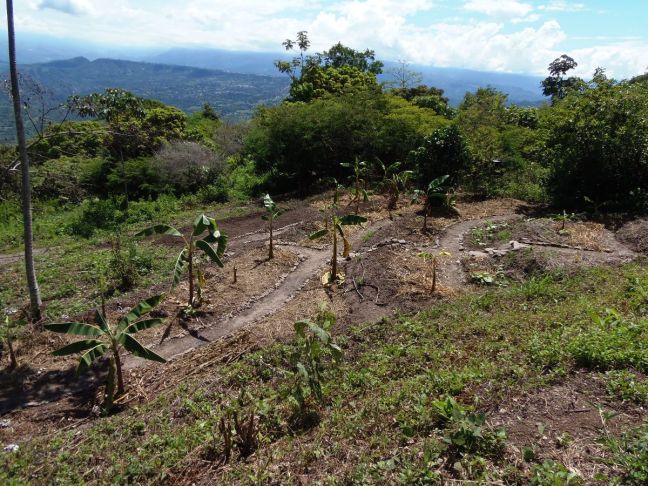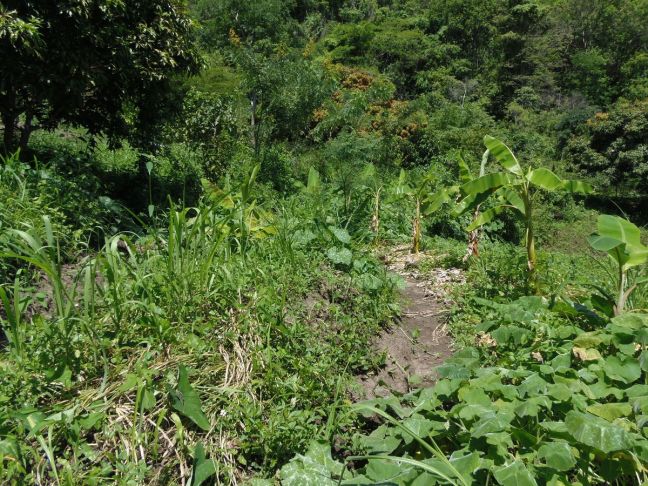How people use the word ‘weeds’ as a negative descriptor of a huge and very varied group of plants already indicates we’re falling prey to over simplistic thinking once again. To consider many plants as totally unwanted shows a denial of how nature functions. Weeds are nature’s answer to disturbed or destroyed ecosystems. Nature does not recognize unwanted plants, she only sees function.
 An unused field, next to our dams, full of a diverse collection of weeds.
An unused field, next to our dams, full of a diverse collection of weeds.
Every disturbance of vegetation is met with a reaction, be it fire, compaction of the ground, plowing, erosion or anything else and weeds are the first emergency responders. Every plant has a ‘germinating condition’ directly connected to the process of disturbance and repair. When for example the soil gets compacted the plants with strong deep root systems emerge to break up the compaction. Is the ground too loose, for example after plowing, then plants with a widespread system of small roots germinate to cast a net that holds the loose soil together. The plants that emerge serve to protect and stimulate life in the soil. That also means that by identifying weeds that grow in an area, you know what the local health and condition of the soil is. Because these plants work to resolve a specific problem or disturbance they are temporary. When their job is done, other plants take over and the first responders die back and disappear. This process continues until the ecosystem is repaired.
In agriculture and in our gardens weeds are considered unwanted competitors of the plants we wish to grow. There is only limited truth to that view. If we see nature for what she is, we learn to look for connections between what grows. Some plants help each other, others stay out of each other’s way by growing different root systems (deep or shallow rooted). But maybe the most important is that all plants achieve a similar goal: they shade the ground and actively cool it by evaporation. These two result in less heating of the soil and by that more water remains in the ground. Competition for water is not really the problem, bare soil is worse than weeds.
 To compare, on the left the soil is still moist, where the bare soil on the right is cracked and dry. This is several days after the last rain. The weeds on the left are only small plants and still achieve sufficient cooling of the soil.
To compare, on the left the soil is still moist, where the bare soil on the right is cracked and dry. This is several days after the last rain. The weeds on the left are only small plants and still achieve sufficient cooling of the soil.
Competition for nutrition is also not a main factor if we can instead see weeds as a storage of fertility and elements needed for plant growth. On bare soil we always have the problem of wind and water erosion that causes nutrients to be blown or washed away. If we let weeds protect the soil and we then frequently mow or cut them, we create an organic layer of mulch that will rot in place and release the nutrients the weeds ‘stored’ for us back to the soil. That layer of mulch then also helps to protect the soil from sun, wind and severe rain showers.

A trick we use on our farm is moving fertility, by taking mowed off weeds from the roads and paths to add to our terraces. We don’t need fertile roads, but only weeds can help us harvest nutrients from these areas for use where we need it.
 Another new terrace, one month after mulching and planting.
Another new terrace, one month after mulching and planting.
To summarize it, weeds are:
- a repair mechanism for disturbed areas.
- ground cover and protection of the soil.
- temperature control for the soil surface.
- storage for nutrients that would otherwise wash away during severe rains, or be blown away by wind erosion.
- mulch that is waiting to be cut down at the moment of your choosing.

